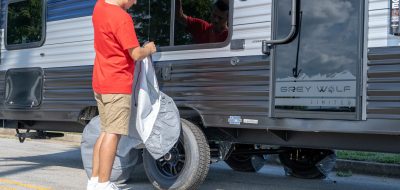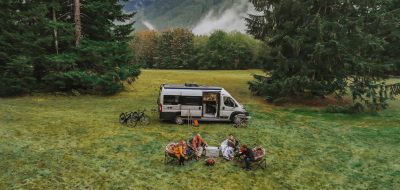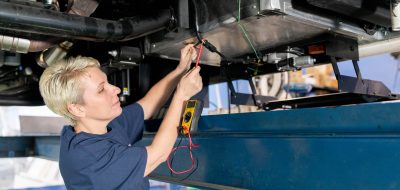 By Ron and Eva Stob
By Ron and Eva Stob
A condensed version of this article appeared in the May 2011 issue of Highways.
We arrived on a Sunday evening at Camp Prendergast in southwestern New York, dropped the trailer and hurriedly drove the 3 miles to the Chautauqua Institution to attend the sacred song service held in the huge covered amphitheater. The event celebrated the Abrahamic religions: Christianity, Judaism and Islam. Representatives from each faith blended separate waters together in a spirit of acceptance and love, then the audience came to fill tiny vials with the blended water as a reminder of the brotherhood of man and our mutual respect for each other.
As has been the tradition since 1907, the service closed with Handel’s Largo, played on the giant Massey Memorial Organ, one of the mightiest instruments anywhere and the largest outdoor pipe organ in the world, with 5,640 pipes ranging from half the size of a straw up to 32 feet. We all remained seated until the last note melted into the night. Only then did we traipse over to the refectory for a double-dip ice-cream cone.
The Chautauqua Institution’s 1893 amphitheater is an all-wood open-sided meeting place seating 5,000. It’s a creaky old structure, uneven and bent from a century of frost and heat that have warped it into a congenial kind of place. Its hardwood benches have taught bony old attendees to bring seat cushions. A flurry of beady-eyed, insect-devouring little brown bats in the rafters help make evenings in the amphitheater pleasant.
 The 750-acre Chautauqua Institution village is marvelously “summer camp” in aspect and feeling. Its many balconied Victorian and Queen Anne summer places have front porches, the air-conditioning feature of 19th century homes. Hanging baskets of ferns and flowers and rocking chairs hark back to Norman Rockwell covers of the Saturday Evening Post. Throw in the stream of children, bicycling adults and older folks clustered on benches in common areas, and you have a summer utopia. The streets are narrow and made for walking and bicycling, with limited access for motor vehicles.
The 750-acre Chautauqua Institution village is marvelously “summer camp” in aspect and feeling. Its many balconied Victorian and Queen Anne summer places have front porches, the air-conditioning feature of 19th century homes. Hanging baskets of ferns and flowers and rocking chairs hark back to Norman Rockwell covers of the Saturday Evening Post. Throw in the stream of children, bicycling adults and older folks clustered on benches in common areas, and you have a summer utopia. The streets are narrow and made for walking and bicycling, with limited access for motor vehicles.
Each summer the Chautauqua Institution hosts a nine-week program where more than 2,000 courses of study are available in a multitude of areas—a potpourri of intellectual interests. The pillars of Chautauqua are arts, education, religion and recreation. It has its own opera, dance and theater companies and a symphony orchestra. Musicians, instructors and students come from all over. The Shakespeare program performs throughout the summer, kids enroll in tennis camp, and the recreation center offers a variety of athletic activities.
The institution was founded in 1874 as the Chautauqua Lake Sunday School Assembly for the training of Sunday school teachers in a summer school promoted by industrialist Lewis Miller of Akron, Ohio. Methodist preacher John Heyl Vincent joined Miller, and the two had a vision that the education of the whole man was the way to enlightenment.
The emphasis at the summer camp shifted from strictly religious education to become a literary and cultural community as well. The founders perceived that the new concept of “free time” fostered recreational and intellectual pursuits, and this idea became the germinal impetus for life-long learning.
Tiny cabins stand near the main entrance—musician’s practice shacks outfitted with a few chairs, a piano and music stands. George Gershwin finished his “Rhapsody in Blue” in one of these. You can see his piano and chair.
The bookstore sold us a copy of the little Walking Tour Guidebook of the Chautauqua Institution, a three-buck book that delineates the history and architectural features of homes and buildings. We began at the colonnade on Bestor Plaza, then headed to the amphitheater, the principle venue for concerts, lectures and worship services. To the south is the Hall of Philosophy. Buttressed with stone columns but open along the sides, it looks like a Greek temple in the woods.
 At the south end of the village is the oldest day camp in America. Based on the number of kids and the bazillion bicycles parked nearby (none with locks), there has to be a slew of young families in residence. A student regatta of Butterfly sailboats tacked out on the water.
At the south end of the village is the oldest day camp in America. Based on the number of kids and the bazillion bicycles parked nearby (none with locks), there has to be a slew of young families in residence. A student regatta of Butterfly sailboats tacked out on the water.
Along the edge of Lake Chautauqua is the Athenaeum Hotel, a marvelously fussy grand dame built in 1881. She stands gaudy and ornate, a stately place with a sumptuous dining hall.
Working our way north along the lakefront, we passed Palestine Park, a miniature landscape likeness of the Holy Land. For the first time in our lives, we gained perspective of Mount Hermon, the high point, and the drainage into the Sea of Galilee, then into the Jordan River, which dead-ends into the Dead Sea.
The Miller Bell Tower was one of the chief entry points when lake steamers brought visitors to Chautauqua. Built in 1911, the 69-foot tower chimes its 14 bells for various occasions and every quarter hour. In the adjacent Pier Building, students were assembling objets d’art from ornamental stained glass. The Chautauqua Belle paddle wheeler plies the lake and makes regular stops near the fishing dock and the bell tower. A boat ride is an excellent way to view the Institution from the water’s edge.
“Paper! Paper! Get your morning paper!” the newsboy cried, as we neared the amphitheater for an illustrated talk by filmmaker Ken Burns. Stephen Ambrose has said, “More people get their history from Ken Burns than any other place.” Burns’ presentation featured the Basilica of St. Mary Magdalene in the French town of Vézelay, a 14th century church that was his focus for an early film made with painter and spiritual teacher William Segal.
We went to church each morning at 9:15 a.m., unusual for us, listening to the Reverend Calvin O. Butts III from the Abyssinian Baptist Church in New York City, chaplain for the week. Butts preached in the style and fervor of Martin Luther King Jr.—in your face, challenging, rising in a crescendo, then closing with a message of discipleship. To sit in the warm summer air in the amphitheater, listening to inspirational and informative talks and enjoying great music, is the special blessing of Chautauqua.
Each evening the amphitheater had a different program. One night was “Songs of Three Cultures” from medieval Andalusia. Another evening the symphony orchestra showcased pianist Patti Wolf. The evening ended with “America the Beautiful,” which felt just right in an institution inimitably American.
Our last evening was with Ken Burns, this time speaking on battlefields and national parks and what makes these places Sacred Spaces, the theme for the week that we were there. Getting Tickets for Events Ticket pricing is complicated. Research online (www.ciweb.org) first, then buy online, by phone or at the visitor center at the main gate. Information about the weekly themes for 2011 is available on the website.
Getting Around at the Institution
Few cars are admitted, so visitors and most residents park in the lot across the street. A shuttle runs through the lot, but we found that we could ride our bicycles down from the parking lot, show our passes at the gate, ride to our destination and park the bikes in the numerous bike racks.
North of Chautauqua
We drove northwest on the Portage Route (State Highway 394), the route of the voyagers from Lake Erie to Lake Chautauqua, which at Mayville follows a natural water route through Lake Chautauqua into the Allegheny River, then into the Ohio and Mississippi rivers. There is a north/south continental divide of 900 feet between Mayville and Westfield where water falling to the west and north runs to Lake Erie, while water falling to the east or south runs to the Gulf of Mexico.
It’s in this area that Welch’s Grape Company has its juice plant because the grape belt extends from the northern part of Chautauqua County into Pennsylvania. In this area, 50 miles long, are 30,000 acres of grapes in a band that is at the most 6 miles wide along the Lake Erie shoreline. The climate is Germanic, and as a consequence Riesling and Gewürztraminer grow well here.
West of Westfield, we stopped at the Noble Winery on Hard Scrabble Road, a winery noted for its sweeping views of the countryside and Lake Erie, visible on a clear day. In their tasting room we sampled their artisan wines—Catawba, Niagara, Fredonia, Delaware and more.
New York’s oldest estate winery is the 200-acre Johnson Estate Winery on Highway 20, west of Westfield. The buildings and land date back to 1822, but it wasn’t until Prohibition that Frederick Johnson began raising grapes (for sacramental use, of course). We tried the Riesling and their notable Chambourcin ice wine.
The Sugar Shack along Highway 5, also known as the Seaway Trail, a designated bicycle route along the shores of Lake Erie, is a center for everything sweet and yummy—farm-made maple products, fruit syrups, butter and jellies made from New York produce. During the growing season, they feature a Sunday pancake meal. Call for reservations (888-563-4324). The Westfield KOA is right across the street.
The Barcelona Lighthouse (circa 1828), one of the oldest lights on the Great Lakes, is along this stretch of Highway 5 near Dan Reed Pier Park.
South of Chautauqua
Bemus Point, a favorite sunset viewing site, is located at a stricture that divides Chautauqua Lake into two nearly equal halves. Chautauqua, a native Seneca Indian word, means “bag tied in the middle.” In times past, the only way to get across the long lake was the Stow Ferry, which ran between Bemus Point and the western shore near Long Point State Park. Bemus Point is still a favorite meeting place with a bevy of boutique shops.
Jamestown Area
Jamestown is the location of the Roger Tory Peterson Institute of Natural History. Peterson, born in Jamestown, is the foremost naturalist of the 20th century. He published the first modern bird watchers’ guide, A Field Guide to the Birds, in 1934, and it has been reprinted many times. The Adirondack-style institute is a memorial, library and resource center that houses Peterson’s body of work, his art and books that he authored and edited.
Lucille Ball was born in Jamestown and found her fame and fortune with red hair, great lips and a Cuban band-leader husband, Desi Arnaz. Together they put together shtick humor that nearly all of us succumbed to and which the promoters say, “Every minute of the day someone, somewhere, is following the antics of Lucy and Desi, as the shows are always being shown somewhere in the world.”
The downtown Lucille Ball–Desi Arnaz Center is actually two museums, the Lucy–Desi Museum and the Desilu Playhouse that capitalizes on Lucy’s fame and holds sets from the shows that ran for nine years. Tapes and interactive displays let you relive the lives of Lucy, Desi, Ethel and Fred. Have dinner in a replica setting, including the food served for that episode (www.lucy-desi.com).
More To Do
• Bicycling on the Rails-to-Trails system
• Golfing at Willow Run, a nine-hole course, and the Donald Ross–designed, 36-hole Chautauqua Golf Course
• Boating on Lake Chautauqua, with launches at several ramps around the lake
• Fishing for pike, bass and muskellunge
• Cruising on the Chautauqua Belle, a 98-foot replica of the original steam-powered paddle wheeler used more than 100 years ago
• Following the Amish Trail through the surrounding communities
RV CAMPING
CAMP PRENDERGAST
Notable for its proximity to the Chautauqua Institution (about 3 miles), this campground has a quiet atmosphere, wooded and sunny sites, a swimming pool, cabins and a playground. www.campprendergast.com
CAMP CHAUTAQUA CAMPING RESORT
Camp Chautauqua is also about 3 miles from the Institution on Chautauqua Lake. It’s a busy place with docks for boats, a launch ramp, a swimming pool and play areas, plus 250 RV sites, both wooded and sunny. www.campchautauqua.com
CHAUTAUQUA HEIGHTS CAMPING RESORT
Located on a hill on the opposite side of the lake, this campground is farthest from the Institution but still only a half hour away. Expect to find a heated swimming pool, sport courts, a laundry facility, a game room, cottages and cabins, a camp store and 150 RV sites. www.chautauquahgts.com
HIDDEN VALLEY CAMPING AREA
The nearest Good Sam Park to the Chautauqua Institution is Hidden Valley Camping Area, just off Route 62 in Jamestown. The park has more than 200 sites and all the amenities, including a laundry room and a convenience store. www.hiddenvalleycampingarea.com




